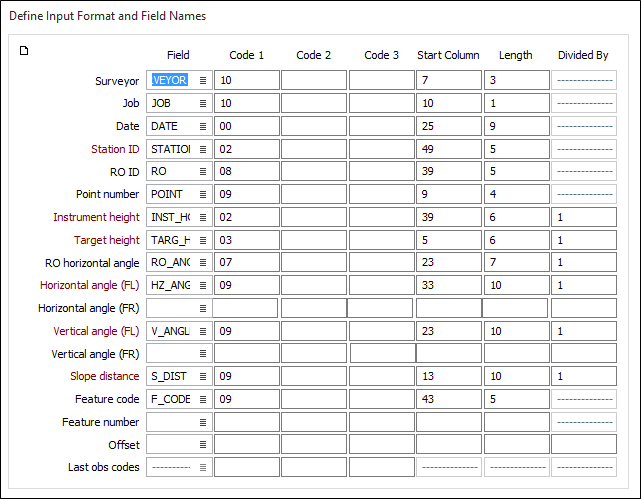Defining the Input Output Format
For each item, you need to enter the (output) file field name to be used, and the following information about the input file:
- The value of code 1 and (if applicable) code 2 and code 3.
- The column number in the file at which each data item starts.
- The length of the item (number of characters/digits).
Measurement items also need a 'Divide by' factor that will be applied to the value when it is transferred to the file in the program.

Code fields
The way in which records are differentiated is by the use of Code fields, identifying text in specific columns. Sometimes several groups of columns are required to uniquely define each record type. The program calls each group of columns containing text that identifies a record a code field, and refers to the text in these columns as code values. Entries in the code fields determine the type of record, so the meaning of the rest of the record can be known. The program can then extract the relevant data from the input stream and place it in the correct fields in the output file.
Divided By
Numeric data often does not include a decimal point (for example, 354.67 may be represented as 35467) and must be divided by some factor to convert it to the correct units. The program lets you specify the factor for each numeric field.
Reference Object (RO)
There are generally four options relating to the Reference Object (RO):
- All observations are true bearings. In this case the surveyor set the true bearing to the RO as the observed horizontal direction. This means that all observed horizontal directions are true bearings. There is no need to apply any correction to the observations to the unknown points. There is no need to record any information regarding the RO.
- The reading to the RO is defined as a code block. The horizontal reading to the RO is part of the Code record. We can extract this value, calculate the true bearing to the RO, calculate the difference between the true bearing and the observed bearing and then apply this difference to all subsequent horizontal readings.
- The reading to the RO is defined by the first observation record. As explained in the Calculating Coordinates of Unknown Points.
- The reading to the RO is always set to 0. In this case, the surveyor set zero as the observed horizontal direction. We can calculate the true bearing to the RO, and then apply this as a correction to all subsequent horizontal readings.
Because of the complexity of the import task, Micromine Australia Pty Ltd will setup your system free of charge. We recommend that you take advantage of this offer.